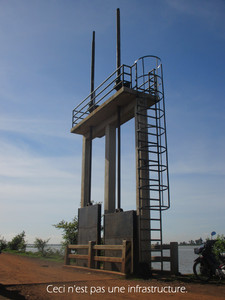Art, the Earth, pipes, insects, canals, soils, people, cables, all have (at least) one thing in common, they have been in the recent years described or read through the lens of ‘infrastructure’. Indeed, infrastructure has been held as a productive metaphor for critical theory and has gained a considerable momentum over the past decade within cultural anthropology and humanities in general. Ranging from bodies and things, from connectivity to disjunction, from invisibility to spectacle, from concrete to smells and sounds, the term “infrastructure” has had many lives under the guiding pen of various scholars who have attended to the myriad intersections that constitute social life (Howe et al., 2016). In the frame of the DELTA project, infrastructure could seem as a natural way for entering into the question of how delta inhabitants deal with and manage water resources. And by water infrastructure, we generally think of these technical systems, be they polders, dams, reservoirs, embankments, sluice gates, that have not only punctuated but defined, in their manner, what deltaic landscapes are or should be. Yet, if infrastructure is undoubtedly a powerful heuristic tool for analysing the complexity of hydrosocial relations, it still requires a certain amount of precaution, at least for two reasons.
There is, first, a risk of misinterpretation that lies in the very notion of infrastructure. From the literature on infrastructure, a twofold stream comes forth, which debouches into studies that look at infrastructure in a literary sense (e.g. roads, energy or water supply grids) and other works that run parallel and refer to the infrastructural in a more figurative way (e.g. river or forests as infrastructures). Within the first current, infrastructure, as defined in physical terms, is a point of departure for exploring the complexity of social dynamics. Recent works have notably shown that what is commonly held as infrastructure such as, for instance, flood control and drainage structures are not merely built and static things with predictable effects, but that they are also social, dynamic and actively implicated in the generation of the relations that humans have with the nonhuman world (See for instance Carse (2016) on droughts as infrastructural events). From another perspective, infrastructure has been held metaphorically, that is that the notion has been extended to many other things from what is commonly understood as infrastructure, i.e. technological systems that are built by man and for man. Aside dikes, buildings, grids and networks, so to say ‘manufastructures’, many other things may also play an infrastructural role. Returning to our delta case, mangroves have for instance been described as having an important role of protection and defence against floods. They have been increasingly viewed as a “natural” or green infrastructure, reminding us the parallel between the ecosystem services and infrastructure metaphors (e.g. see World Bank, 2016). Paddy fields and rice varieties, such as floating rice have also been considered as infrastructures, in that they allow to turn the floods into food, being adapted to the deep water environment of deltaic floodplains (Morita, 2016). But what is infrastructural in floating rice is certainly connected to the specific pedological conditions of deltas and to soils that sustain the growth and decay of rice plants. Can we then speak of soils as another infrastructure for managing the land and water in deltas? And, by seeing soils or even rivers as infrasystems, we may come to view the milieu as another infrastructure with the Earth being the infrastructure on which all infrastructures are constructed. While this sounds voluntarily provocative, it, however, illustrates that, because of the peculiar ontology of infrastructure as “things and also the relations between things” (Larkin, 2013), it rapidly becomes difficult to see what they are, or better put, what they could not be. This is fine up to a point. But because the term infrastructure is often used unquestionably, it adds complexity to the understanding of what is meant by “infrastructure”. The potential for confusion is far more significant in the field of water management where infrastructure is strongly associated with the image of engineered systems, such as flood and irrigation systems.
A second point is that by turning to infrastructure, we are at risk of taking it as the centre of gravity of what constitutes hydrosocial relations. With an infrastructural analytic, we only highlight one particular dimension of social and watery movements, one specific aspect, schema and logic of functioning. By failing to define what is actually meant by infrastructure (and as far as they extend), there is hence a risk to veil the existence of other rationalities, values, meanings, in that infrastructure often fosters a utilitarian and functional view of social and ecological relations (i.e. infrastructure, a utilitarianism?). All in all, the sudden interest on infrastructure raises some question such as why now? (See for instance contributions of Appel et al. 2015) What does infrastructure can bring to our understanding of hydrosocial relations that other metaphors or tools embracing notions of connectivity or fluidity are not offering? Are we using the notion of infrastructure because we are convinced of its metaphorical power or because it helps a more useful approach? And, finally, isn’t it without using (so naturally) the term ‘infrastructure’ that we may perhaps grasp what is actually making an infrastructure?
References
Appel, H., Anand, N., Gupta, A., 2015. "The Infrastructure Toolbox." Theorizing the Contemporary, Cultural Anthropology website, See https://culanth.org/fieldsights/725-the-infrastructure-toolbox
Carse, A., 2016. “Drought as Infrastructural Event.” Limn 7, Public Infrastructures / Infrastructural Publics
Howe, C., Lockrem, J., Appel, H., Hackett, E., Boyer, D., Hall, R., Schneider-Mayerson, M., Pope, A., Gupta, A., Rodwell, E., Ballestero, A., Durbin, T., el-Dahdah, F., Long, E., Mody, C., 2016. Paradoxical Infrastructures: Ruins, Retrofit, and Risk. Science, Technology & Human Values 41, 547–565.
Larkin, B., 2013. The Politics and Poetics of Infrastructure. Annual Review of Anthropology 42, 327–343.
Morita, A., 2016. Infrastructuring Amphibious Space: The Interplay of Aquatic and Terrestrial Infrastructures in the Chao Phraya Delta in Thailand. Science as Culture 25, 117–140.
World Bank, 2016. “Nature as the first line of defense against floods”, World Bank website, See http://www.worldbank.org/en/news/feature/2016/02/10/nature-as-the-first-line-of-defense-against-floods

